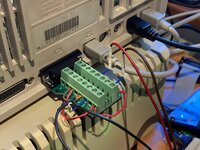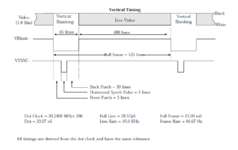Thanks, yeah it makes sense that the exact duration of those sync pulses isn't critical, so long as the period between them is correct.
Now we're finally getting to the interesting part. I connected the LM1881's VSYNC output to VGA VSYNC, and LM1881 CSYNC output to VGA HSYNC. This second connection isn't really correct - CSYNC is not HSYNC - but I've been told that many monitors will accept CSYNC on their HSYNC input as long as they also have a separate VSYNC signal. Thanks to the LM1881, now I have that missing VSYNC signal. Here's the finished adapter: it really is a big mess o' wires, and something so ugly that only a mother could love it.

As you may recall, I have one monitor that's worked with my IIci's built-in video all along: a Dell 2001FP. And three monitors that do not work, no matter what settings I have tried on the VGA adapter: a Viewsonic VG900b LCD, Viewsonic 6 CRT, and E-Machines CRT.
As I sanity check, I tried the Dell first:
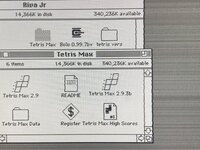
It still worked, but ouch the video quality was lousy: all kinds of shimmering and noise in the image. Maybe it was a result of my messy nest of wires snaking everywhere? At least there was a usable image.
Next up, the Viewsonic VG900b LCD. This was the real test, since this monitor steadfastly refused to sync with my IIci video before. Would it work now?
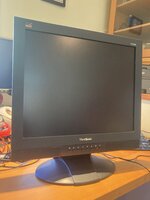
Whomp whomp, so sorry. No love from the VG900b, which still complained there was no video signal and then went to sleep. Disappointing. Maybe it doesn't like CSYNC as HSYNC, or maybe it doesn't like the CSYNC that's also still present on the RGB channels.
OK, how about this Viewsonic 6 CRT? It never worked with the IIci video before, but how about now?
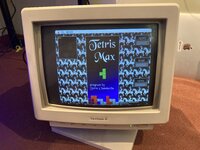
Success, it worked! The image quality was pretty good too. Still a little bit of shimmer, but much less than with the Dell 2001FP. I'm not sure why the difference, maybe something about digital versus analog video circuitry?
The final test was the E-Machines 16 inch CRT. This was the third member of the fussy trio that had refused to work with my IIci built-in video before:

Huzzah! It also worked. Image quality was similar to the Viewsonic CRT: some shimmer, but not too bad.
That's a score of 2 out of 3 for this Mac-LM1881 adapter. Useful enough to deserve being made into a proper PCB kit, I think. The only thing I didn't test was powering the LM1881 with phantom power stolen from the Mac's HSYNC and VSYNC signals, which are always high in this configuration. I've taken this snarl of wires as far as it can reasonably go, so that test will need to wait for later. I'll probably design the PCB so that it's configurable whether to use stolen power or to connect a separate 5V voltage source.
